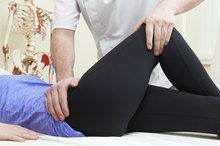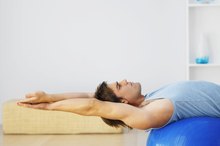What does fact checked mean?
At Healthfully, we strive to deliver objective content that is accurate and up-to-date. Our team periodically reviews articles in order to ensure content quality. The sources cited below consist of evidence from peer-reviewed journals, prominent medical organizations, academic associations, and government data.
- Mayo Clinic: Meralgia Paresthetica
- "Archives of Physical Medicine and Rehabilitation": Myofascial Pain: Relief by Post-Isometric Relaxation; K. Lewit and D. G. Simons; August 1984
- "Archives of Physical Medicine and Rehabilitation": Myofascial Pain: Relief by Post-Isometric Relaxation; K. Lewit and D. G. Simons; August 1984
- Mayo Clinic: Meralgia Paresthetica, Lifestyle and Home Remedies
- Mayo Clinic: Meralgia Paresthetica, Lifestyle and Home Remedies
The information contained on this site is for informational purposes only, and should not be used as a substitute for the advice of a professional health care provider. Please check with the appropriate physician regarding health questions and concerns. Although we strive to deliver accurate and up-to-date information, no guarantee to that effect is made.
Meralgia Paresthetica & Pregnancy Exercises
Meralgia paresthetica is a neurological condition characterized by pain or numbness along the outer thigh. Also known as Bernhardt-Roth syndrome, this disorder is caused by trauma or compression to the lateral femoral cutaneous nerve, which travels from the thigh to the spinal cord. Meralgia paresthetica commonly occurs in pregnancy owing to weight gain. Because medications or surgery are not advisable during pregnancy, you may be able to relieve symptoms with exercise.
If you are experiencing serious medical symptoms, seek emergency treatment immediately.
Diagnosis
Patients normally undergo tests such as X-ray imaging to rule out other conditions that might mimic meralgia paresthetica. If you are pregnant, however, your doctor is more likely to conduct orthopedic tests instead. For instance, a Kemp test, which your doctor can perform while you're sitting or standing, checks for abnormalities in your spinal discs. The Ely test, performed while you're lying down with the affected thigh hyperextended, reveals inflammation or adhesions involving lumbar nerves.
- Patients normally undergo tests such as X-ray imaging to rule out other conditions that might mimic meralgia paresthetica.
- The Ely test, performed while you're lying down with the affected thigh hyperextended, reveals inflammation or adhesions involving lumbar nerves.
Physical Exercises
Groin & Hip Pain Upon Standing & Walking
Learn More
According to a case report published in a 2006 issue of the “Journal of Chiropractic Medicine,” a 22-year-old pregnant woman with meralgia paresthetica treated the condition using the "cat-camel" exercise. The lead researcher in the case, Clayton D. Skaggs, D.C., indicates this exercise helps to “floss” the lumbar nerves in the pelvic area. The exercise begins with the “cat” position of resting on all fours, or hands and knees. The “camel” portion calls for tucking the chin into your chest and arching your back. Slowly, you reverse these steps and dip your stomach to the floor to stretch your neck and spine.
Another technique is abdominal bracing, which you also perform on all fours. In this exercise, you pretend that you are about to receive a punch to the stomach. As you brace your muscles for impact, you push your shins into the floor or an exercise mat. With repetition, this exercise strengthens lateral trunk muscles and improves the stability of the spine and pelvis.
- According to a case report published in a 2006 issue of the “Journal of Chiropractic Medicine,” a 22-year-old pregnant woman with meralgia paresthetica treated the condition using the "cat-camel" exercise.
Manual Manipulations
If physical therapy is part of your regimen, your therapist will likely perform a variety of soft tissue manipulations. For example, the Active Release Technique, or ART, relieves potential adhesions in soft tissue that hamper movement and entrap nerves. The post-isometric relaxation technique, or PIR, is another technique that involves stretching a targeted muscle or group of muscles to the point of reaching isometric contraction, meaning held at a constant length instead of being permitted to lengthen or shorten 1. In addition to restoring function, this technique also reduces pain.
- If physical therapy is part of your regimen, your therapist will likely perform a variety of soft tissue manipulations.
- The post-isometric relaxation technique, or PIR, is another technique that involves stretching a targeted muscle or group of muscles to the point of reaching isometric contraction, meaning held at a constant length instead of being permitted to lengthen or shorten 1.
Effectiveness
Tingly Feeling When Doing Pull-Ups
Learn More
The patient in the "Journal of Chiropractic Medicine" case study experienced a 90 percent improvement of symptoms after six exercise and manual manipulation sessions 1. She was also able to continue symptom management by performing the prescribed exercises at home. In fact, she was still pain-free at follow-up one year later.
Additional Measures
The Mayo Clinic recommends additional self-care measures to help reduce meralgia paresthetica symptoms. Try to avoid walking or standing for long periods of time. Also avoid tight clothing, which can increase pressure on lateral nerves.
Related Articles
References
- "Archives of Physical Medicine and Rehabilitation": Myofascial Pain: Relief by Post-Isometric Relaxation; K. Lewit and D. G. Simons; August 1984
- Ivins GK. Meralgia paresthetica, the elusive diagnosis: clinical experience with 14 adult patients. Ann Surg. 2000;232(2):281–286. doi:10.1097/00000658-200008000-00019
- Cheatham SW, Kolber MJ, Salamh PA. Meralgia paresthetica: a review of the literature. Int J Sports Phys Ther. 2013;8(6):883–893.
- Chung KH, Lee JY, Ko TK, et al. Meralgia paresthetica affecting parturient women who underwent cesarean section -A case report-. Korean J Anesthesiol. 2010;59 Suppl(Suppl):S86–S89. doi:10.4097/kjae.2010.59.S.S86
- Grossman MG, Ducey SA, Nadler SS, Levy AS. Meralgia paresthetica: diagnosis and treatment. J Am Acad Orthop Surg. 2001;9(5):336-44. doi:10.5435/00124635-200109000-00007
- Hosley CM, McCullough LD. Acute neurological issues in pregnancy and the peripartum. Neurohospitalist. 2011;1(2):104–116. doi:10.1177/1941875211399126
- Houle S. Chiropractic management of chronic idiopathic meralgia paresthetica: a case study. J Chiropr Med. 2012;11(1):36–41. doi:10.1016/j.jcm.2011.06.008
- Schwaiger K, Panzenbeck P, Purschke M, et al. Surgical decompression of the lateral femoral cutaneous nerve (LFCN) for Meralgia paresthetica treatment: Experimental or state of the art? A single-center outcome analysis. Medicine (Baltimore). 2018;97(33):e11914. doi:10.1097/MD.0000000000011914
- Ivins GK. Meralgia paresthetica, the elusive diagnosis: clinical experience with 14 adult patients. Ann Surg. 2000;232(2):281–286. doi:10.1097/00000658-200008000-00019
Writer Bio
Karyn Maier is a seasoned columnist and feature writer. Since 1992, her work has appeared in Mother Earth News, The Herb Quarterly, Better Nutrition and in many other print and digital publications. She is also the author of five books, and is published in six languages.








